
I had mentioned in many of my articles before that travelers help each other to find places to overnight. This can be a place just to camp or a family’s, a friend’s house. When I told that I’m riding from Cusco to Calca, the travelers who had traveled in Peru said: “You can stay at the establishment managed by two Turks in Calca, they will certainly offer a room for you.” Alright, I will meet them, Mert and Alper. Alper is a former textile businessman and Mert is a software developer formerly worked for Google. The place they have met and established a business was Calca in Peru, they opened a hostel. The name of the hostel is “El Mono Sabio” or translated into English “wise monkey”. I didn’t ask them why they have chosen this name.

I had the opportunity to chat with Mert on Facebook before arriving there. Especially, Elif Uzer kept saying: “Go there, they are really very nice people”. I asked Mert, while I was riding with two other cyclists, whether he could host us on their backyard for a while. We were told that they had a huge garden. Mert replied as: “No need to put up your tents in the garden. We have plenty of place. Friends of our friends are also our friends (a common saying in Turkish)”. I do not like to stay for free at a room at such places. I either prefer to pay or stay in my tent (I paid for the days I stayed there). Together with Annie and Will, we arrived in Calca from Cusco in a short time. This short road climbs at the beginning but then there is a nice descent to the valley. There is a settlement called Pisac before Calca. This is a town more famous than Calca because there are ancient ruins and agricultural lands dating back to Inca Empire just around this town. It is possible to see ancient stonework partly on the walls of these constructed terraces to gain agricultural land. On these terraces, potatoes are still grown. While descending to the valley, the faces of the mountains looked weird to me as if the heavy wind blowing from the top twisted the soil into a different formation.
The town’s atmosphere changes totally just going the street behind the main road in Pisac. Nice streets, colonial period architecture and a large main square welcome us. The main square is surrounded with cafes and hostels, a familiar touristic look. The old Peruvian ladies dressed colorfully add up to the view.
It is possible to see small towns with similar features along the Sacred Valley. However, Calca is not one of these towns. Though there are colonial period dwellings around the city square, it is a much modern town compared to the other settlements along the road. Modernity is good in such that accommodation and food are much cheaper compared to the other settlements. While waiting for Annie and Will just outside Calca, I look at the hill behind me.
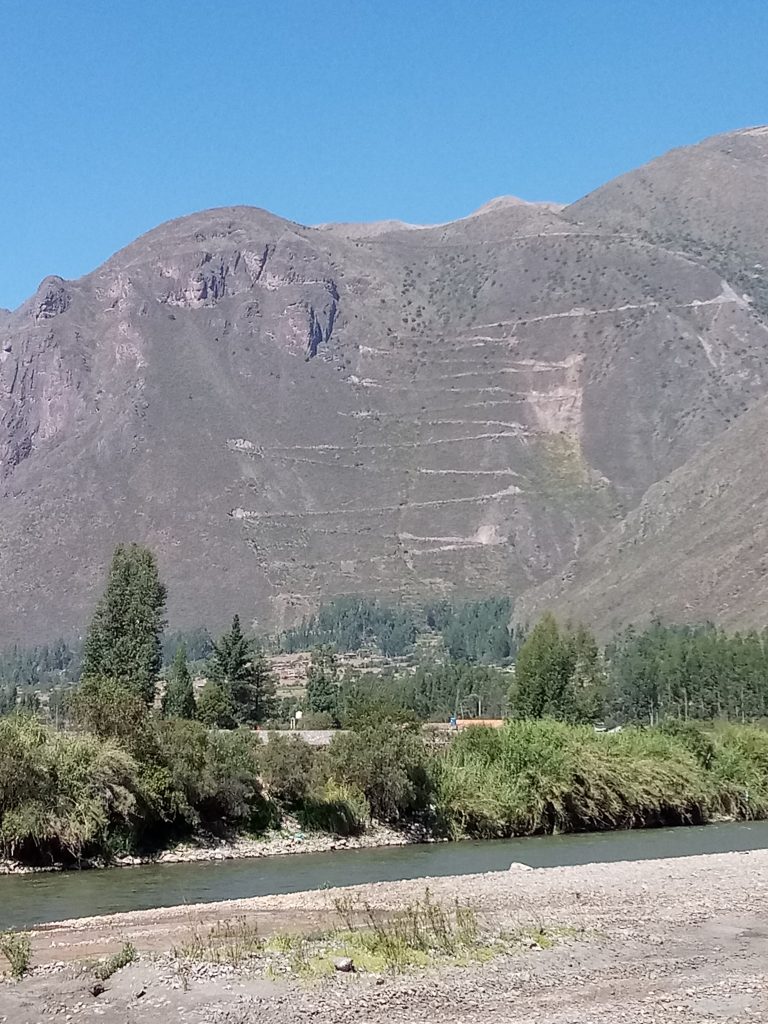
-Wow, how come, what a hill is this, where is the road going to? Does this road connect to somewhere? Dude, I hope it does. If it is so I definitely climb this hill.
I immediately opened GPS. Well, the road goes up to a point but then it becomes a pathway. If Garmin shows it like this, I’m sure it is not suitable for cars. Well, can a bike go on this road? I opened Google Map, but it also shows the road ending at the same point and even does not show the pathway. But I have an internet package, so I switch to the satellite view. Yep, here I see the path. Wow, is there a valley on top of the hill? Dude, I’m already at 2800 m altitude. How come, a valley? Humm, there is no road, interesting. Anyway, I’ll ask Mert and Alper. Meanwhile, Annie and Will arrived.
– Hey! Look at this winding road. When you exit Calca, you can also use this road. If it connects to somewhere at the back, this seems to be a gigantic climb on this winding road going up this steep slope.
– Gurkan, are you out of your mind? Our bicycles probably won’t be able to climb to the top.
– You can push if you can’t ride. But we need detailed information about this road. I don’t want to climb just to return if it doesn’t go anywhere.
-Well, that will be a very painful experience, hahaha.
Arriving in Calca, we rode through the town towards the mountains to the skirts of the town where the hostel is located. Alper and Mert were not at the hostel. But we met Albert, an American, who does voluntary work at the hostel and for this work he stays for free. He was informed that we were coming and a room for 6 people was already reserved for us. Two other Turkish citizens, Ahmet and Riza, if I’m not wrong, were also staying at this hostel. The next days, two French cyclists also came to the hostel.
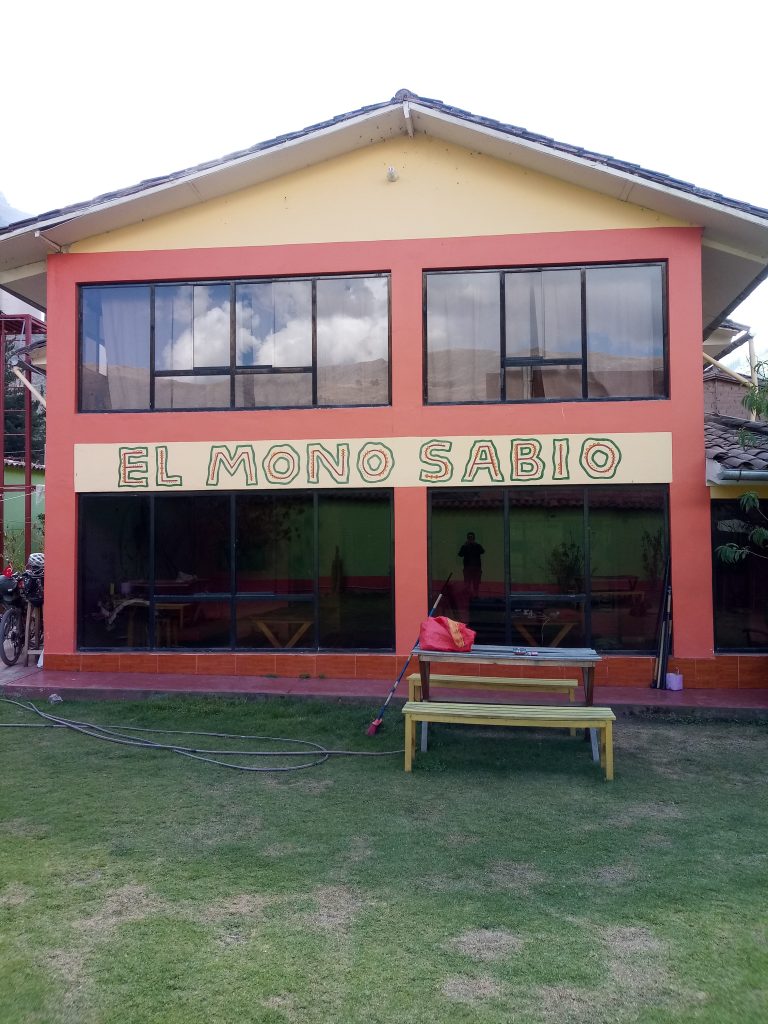
There were many Turks who settled down in Calca with all kind of life experiences, having distinctively lively and spirited quality, well educated people. Some came here relying on their own savings, some trying to hold on. Some receive support from their families back in Turkey in hard times. In general, they all didn’t want to establish a business in Turkey, left their country due to various reasons as bad business conditions, economics, government etc. And started to a new adventure in a different country.
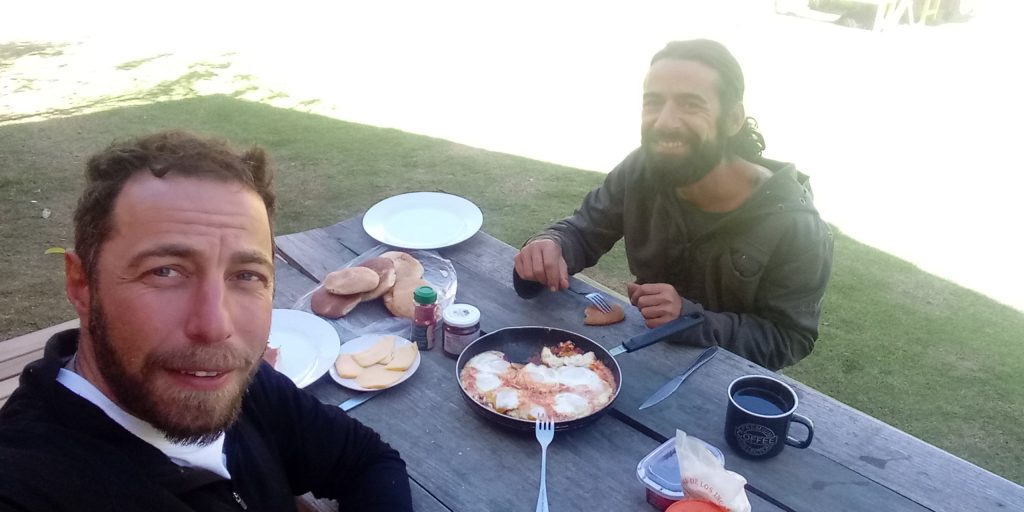
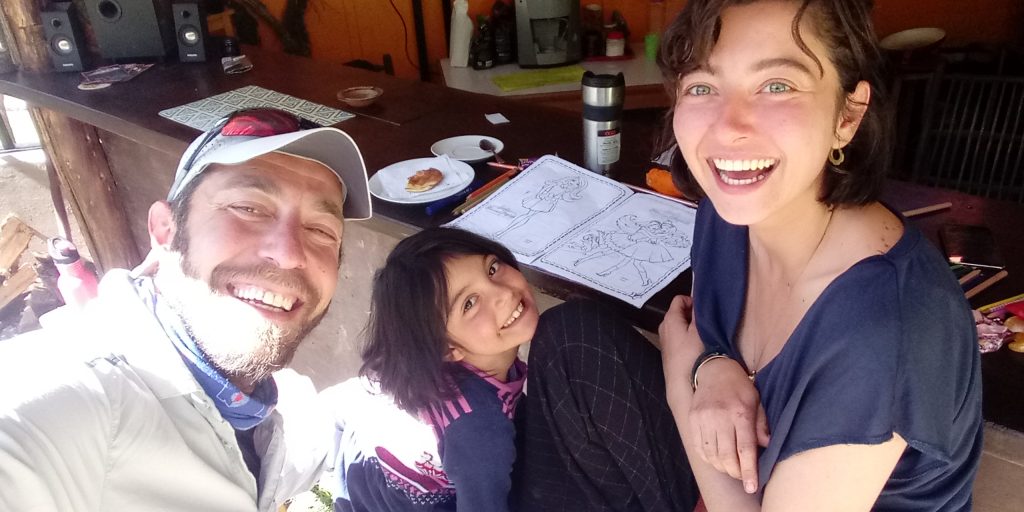
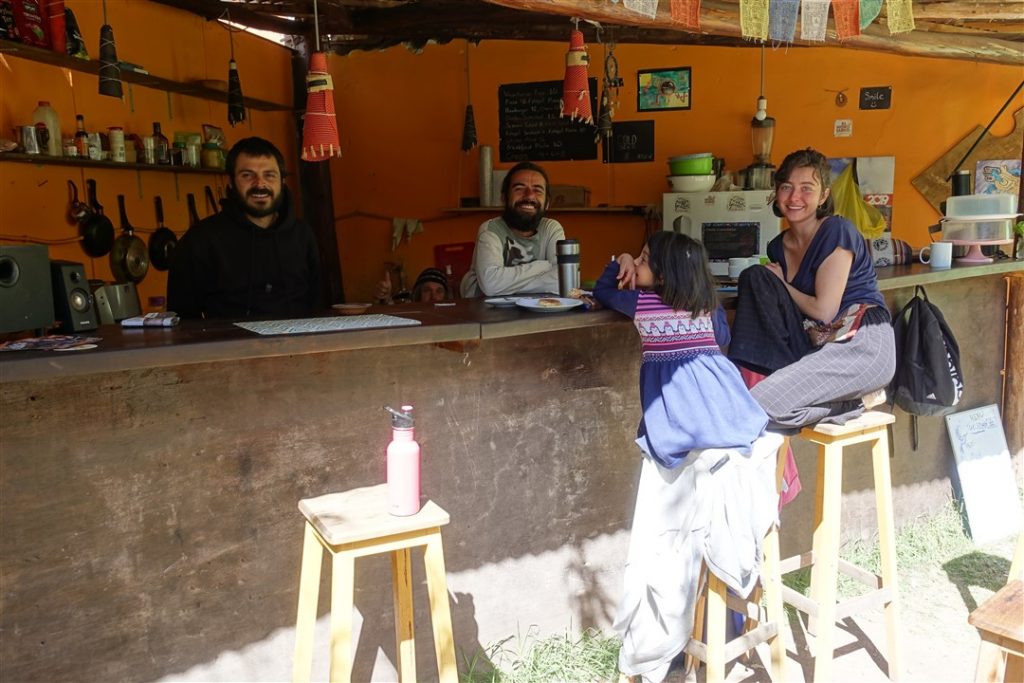
There is another reason why people from my country and many other countries come to this valley and settle down. As it is known, before Christianity the communities living here were arranging their relations with their gods via Shamans. Those shamans were transferring power to the soldiers, painting themselves with holy invincible colors, poisonous spearheads, medical plants for curing, etc.,etc. They were sacrificing young virgin girls to the gods at ceremonies for more rain or for a good harvest. I wanted to write down as it came in my mind; since Incas are known I’ll write about Incas as example.
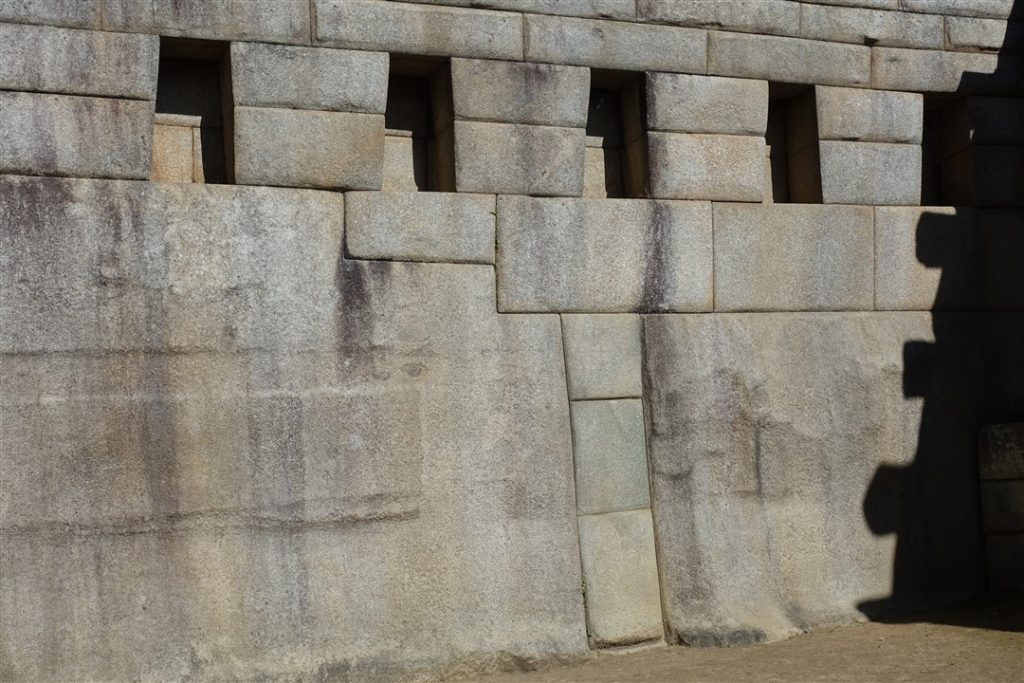
For example, if I want to have a Peruvian mason to build a stone house for me and ask him to do the same stonework as it was done 700 years ago, he wouldn’t be able to do. On the other hand, you can have built an ancient roof design in Africa, in Scandinavia. The reason for this is, that their ancestors didn’t teach how to practice this type of masonry to the next generation. You can observe this from the renovation works done by Peruvian archeologists and masons and even in renovation work in Machu Picchu explored in 1911. Alright, the colonial period had a bad impact, but this is masonry, dude. You need to build your own house, a line of work to feed you. On the other hand, not a single medical plant the Shamans had used has survived to this period. Furthermore, there isn’t any world-wide famous curative product in Peru. The physicians and authorized people in medical sector in the other countries in South America also say: “Peru is the last country where we would seek for experience or medicine on health issues”. I had mentioned about Alpaca issue in textile industry how it is handmade processed in my first Peru article. The main reason why this handmade process survived to this day is that women are involved in weaving.

Somehow the shamanic ritual with the tea made from Ayahuasca leaves and San Pedro cactus held since 600 to 1000 years has survived till now but not the stone masonry which has an economical value as building house, earning money etc. The shamanic knowledge which is important for people living strongly connected to nature has survived till present day. As I always mention, if road has arrived in a settlement nothing will remain the same anymore.
The dimethyltryptamine (DMT) content is higher in these plants compared to that in the others and if the extract dosage is properly adjusted it results in hallucination. Actually, by digesting you increase the amount of DMT already present in the body to a poisonous level and the body shows reactions, one of which is hallucination. Peru has only a 100 years of tourism experience. That is, ask anybody in Peru, there is at least a shaman in every family. The chakra center of the world is here, also the doors to otherworld is here, well, if you believe. After trying this there might be someone who will say “What is this? Is that all?” as me, the reply will be as: “The whole thing is about to come upon a good shaman. Furthermore, you have to obey to the diet program, etc. etc.”
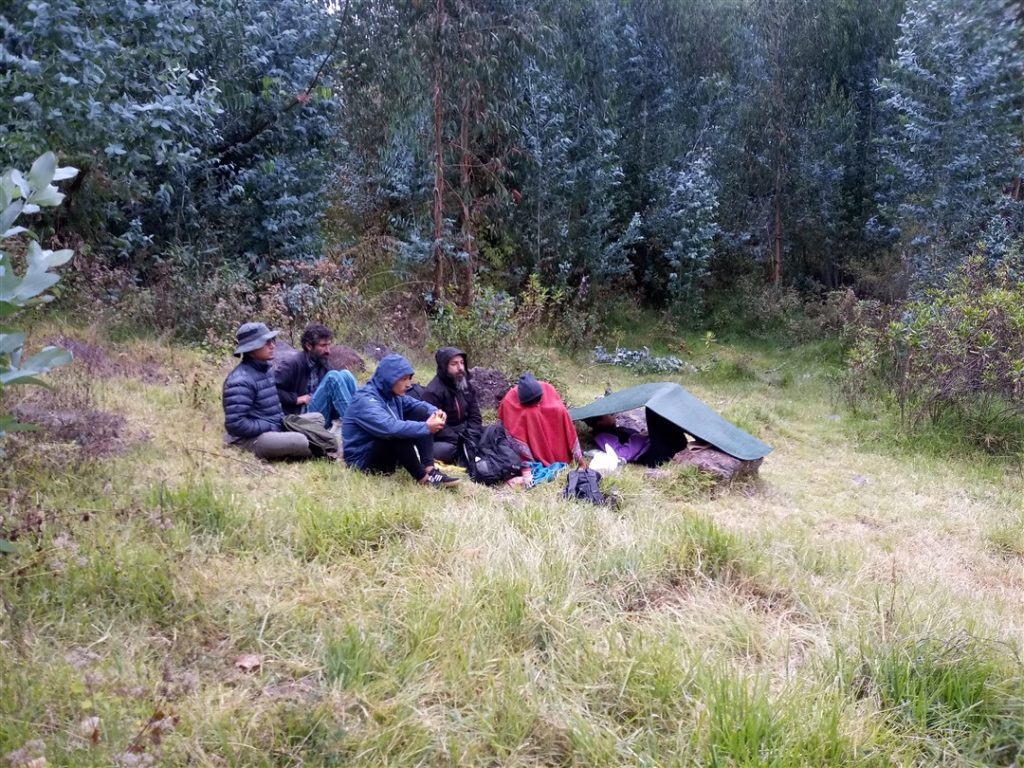
At this point let me mention my opinion. As in other continents, also in this continent, children had been sacrificed for gods. They were either killed or tied up and buried or other things were done. One of the rituals done in this continent was tranquilizing the children with herbs and putting them on adequate diet for that. Well, it is important before the sacrifice ceremony. Today, this continues under “diet” for commercial purposes. In short, this is my opinion. I believe in body energy but just ignore such incoherent issues.
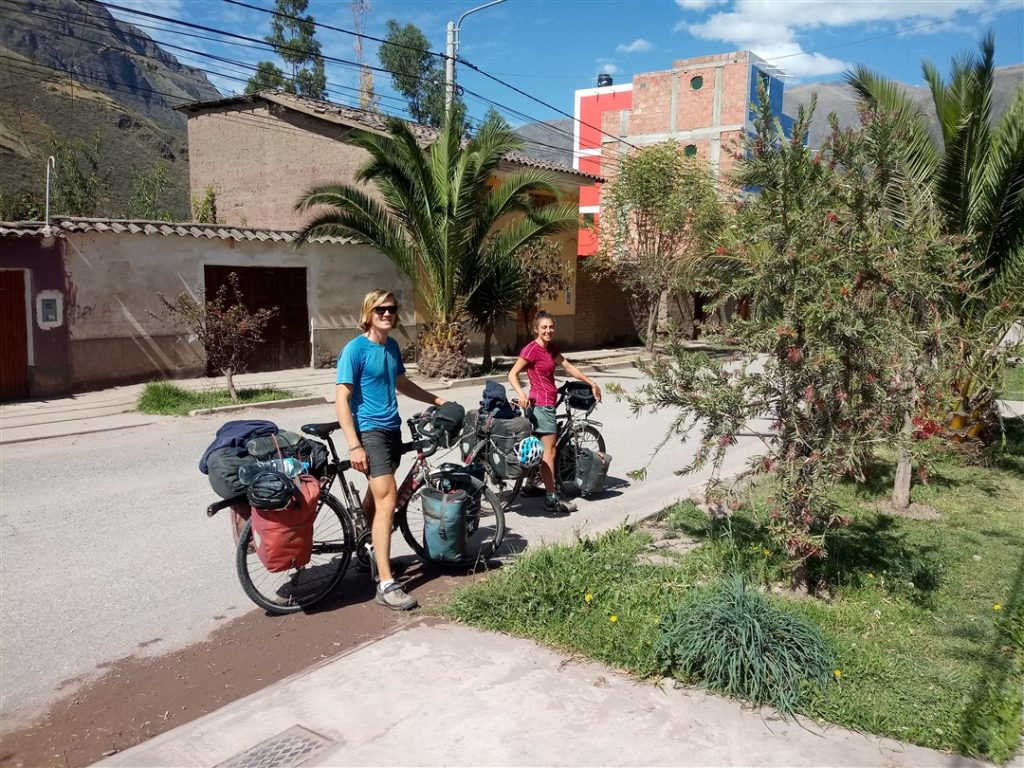
I rested in Calca for 5 days staying with Annie and Will. Then, they decided to continue. Well, don’t they go to Machu Picchu? Well, I had mentioned about under which conditions they had set off for their journey in my first writing. This is a reality: If you have enough money to go to Machu Picchu, then you either do not have a budget problem or got sponsored by your family. But if you have just set off like these young people for a world tour, then you cannot afford to go to places which is on the top of everybody’s list. The entrance fee is 45 USD. Before, Annie and Will set off, two other touring cyclists came to the hostel where we were staying at. They stayed only for one night. They had bought the entrance tickets for Machu Picchu from internet for 55 USD. Why did they overpay? This ancient city has certain visiting time regulations, and the number of visitors is limited for each period. Furthermore, also you have to pay entrance fees for several other places within the ancient city. They had bought their thickets on internet to ascertain their entrance into the ancient city. Since I didn’t read that people could not enter the city on the blogs or heard from my friends, I didn’t bother to buy the entrance ticket in advance. By the way, I advise you to go to the Butterfly restaurant if you visit Calca. Drink a glass of tea and eat their delicious cakes if they have and say hello from me.

For a moment I thought to ride till Aguas Calientes located below Machu Picchu from here. There are a couple of cyclists who have ridden this route. Is it worth? NOT for sure. Do not do it. I left my bicycle at the hostel in Calca and took the 8 a.m. minibus to Urubamba. Then, I took another minibus to
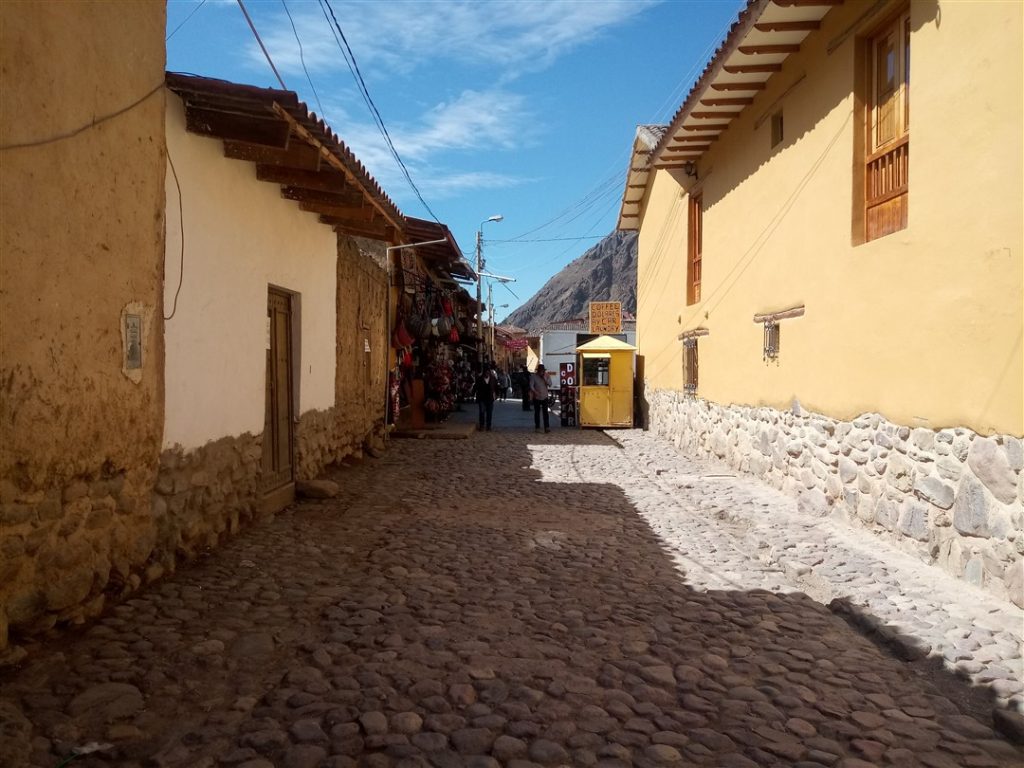
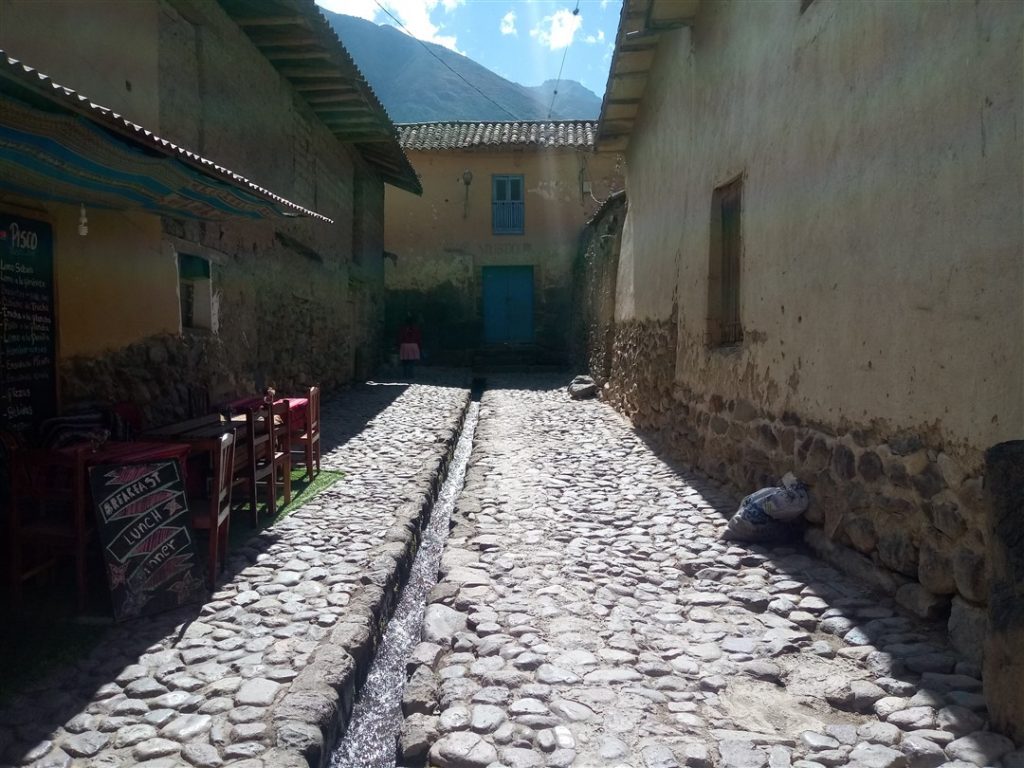
By this way, I used one of the minibuses departing from Cusco, heading to Quillambamba direction, and got off the minibus at Santa Maria village. This journey till here is on a single lane road climbing to 4000 m altitude and it took 8 hours to arrive together with the waiting times at the stations. Since I arrived in Santa Maria at 4 p.m., I shared a taxi to Hidroelectrica station with people who got off the minibus and trying go to Machu Picchu as I was. It was almost 6 p.m. and starting to get dark. After this point the walking distance to the town Aguas Calientes is 11 km changing from 1500 to 2500 m altitude. So, during your walk you also climb slowly. Arriving in the town, with up and downs your total climb sums up to 1115 m. Since I started to walk after it got dark, it took me 1 h and 52 min to finish this 10 km distance. I am sure that this will shorten during a day walk. I walked alone and must say that it was safe. You better wear a head lamp but also the moon light was efficient at some parts of the walk. Furthermore, the visual play of fireflies was worth to see.
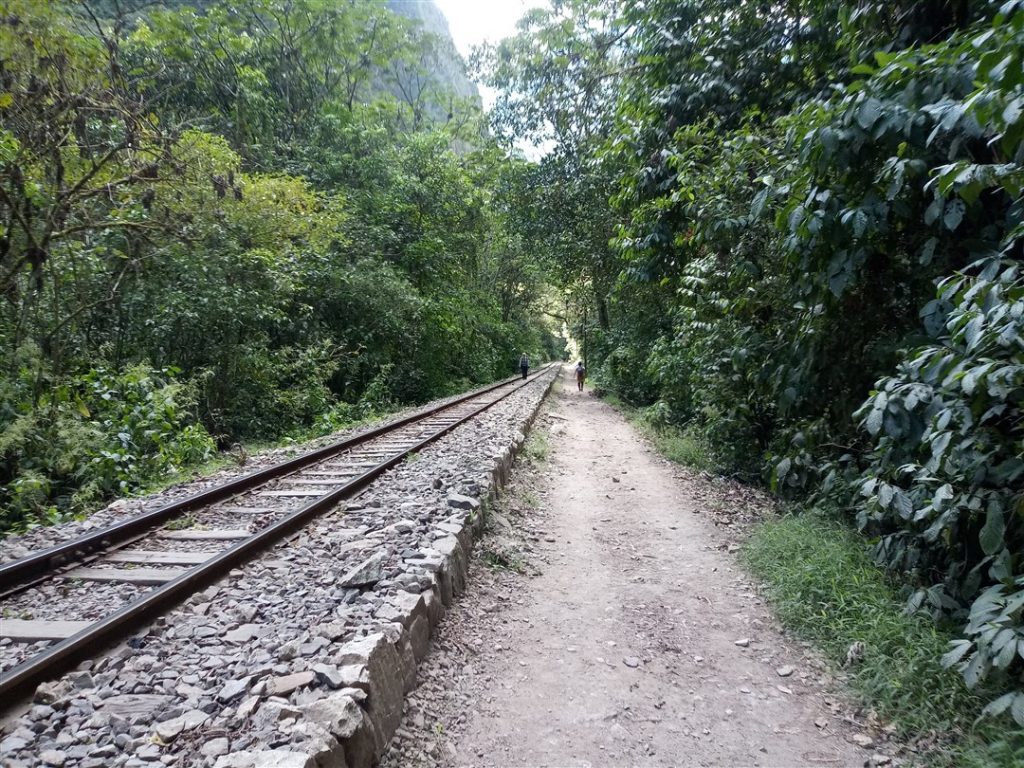

Well, you follow the railroad, but doesn’t the train go to the city? It does, even the only transport vehicles that could reach the city are train and bicycles! As I mentioned before, you can ride till this town, but it is not worth. The only reason I didn’t take the train was its price, 150 USD. For natives it costs only 5 or 10 USD, but for foreigners a hell lot more. Therefore, people, even the ones who don’t like to walk like me, prefer to walk. I don’t think that you’ll face any accommodation problems in Aguas Calientes. I arrived at 8 p.m. and could find a place to overnight. I took a shower and did some laundry and then went to the ticket office. I bought a ticket for 6 a.m. entrance to Machu Picchu. I prepared my bag and put some snacks since I was going to leave early in the morning.

The town Aguas Calientes is located at 2000 m and Machu Picchu at 2428 m is located 2.5 km away from the town. The road going up is the ancient Inca road. The unstable various sized stones make the walk difficult. You get tired. I finished the walk in 34 minutes in 2019 still among the fastest 40 people till now. The first person finished the route in 27 min (How come? Did you use a rocket, so fast? The ones who walked on this road would understand what I mean). Honestly speaking, the descent on this route was worse. So, why I didn’t take a vehicle? The price for 2.5 km is 12 USD, therefore many people prefer to walk.
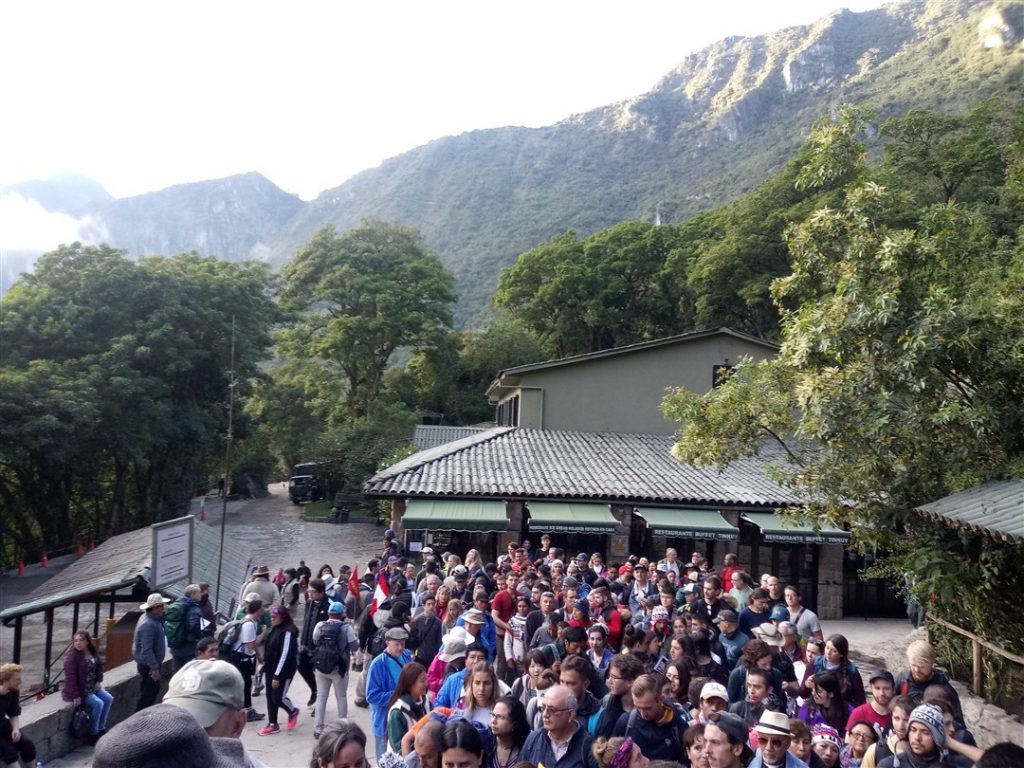
When I arrived on the top with hundreds of people and lined up in front of the entrance door. We were all waiting for the opening time at 6 a.m. The priority of everyone is to take a selfie, that famous selfie “here I’m at Machu Picchu” before it gets crowded. You see those photos on Instagram, on Facebook where there are no people around. Dude, it is 6 a.m. and hundreds of people are waiting in the line. The door opened and everyone rushed to the most scenic spot. The ticket costs 45 USD for entrance but nothing more, even not a brief information booklet.
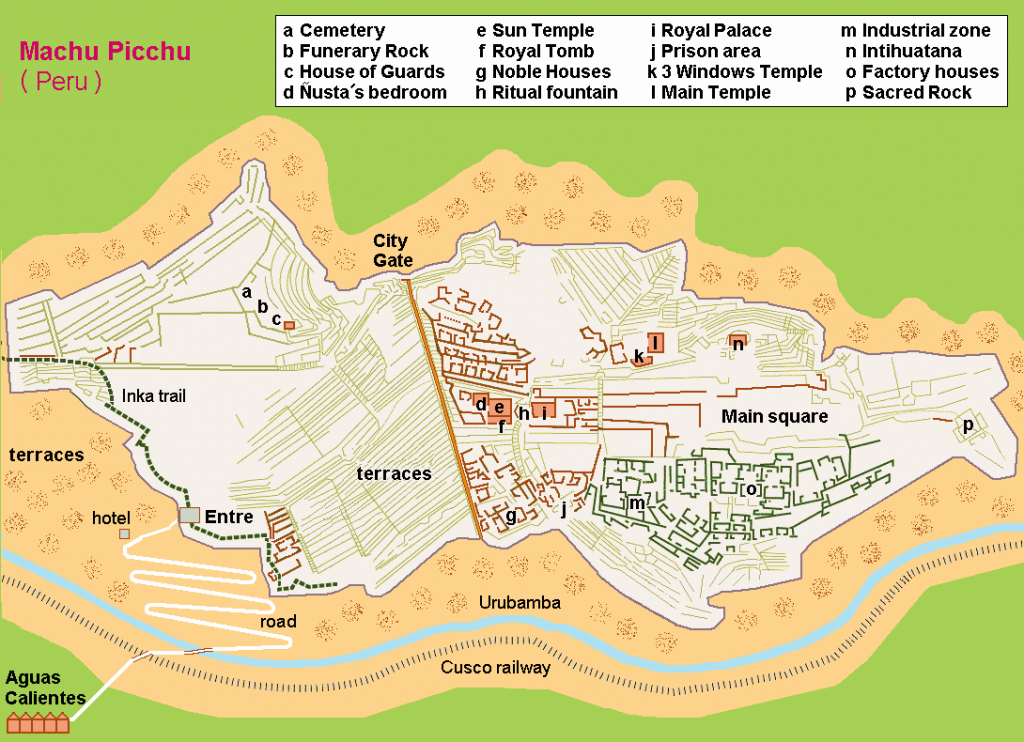
Where is this place? Yep, I saw the mountain. Rush to the top, take a U turn, then you arrive, take a photo, and then exit. Don’t laugh! There are people behaving exactly like that but not me of course. I came here at 6 a.m., paid 45 USD, if they would allow me, I would put up a tent and stay (did it before many times, asked for permission to camp in an ancient city). I calculated how long it will take to return to the main road before it gets dark. I had snacks and water in my bag. That’s it, I have 8 hours to explore this ancient city. I walked on every inch of this ancient city.
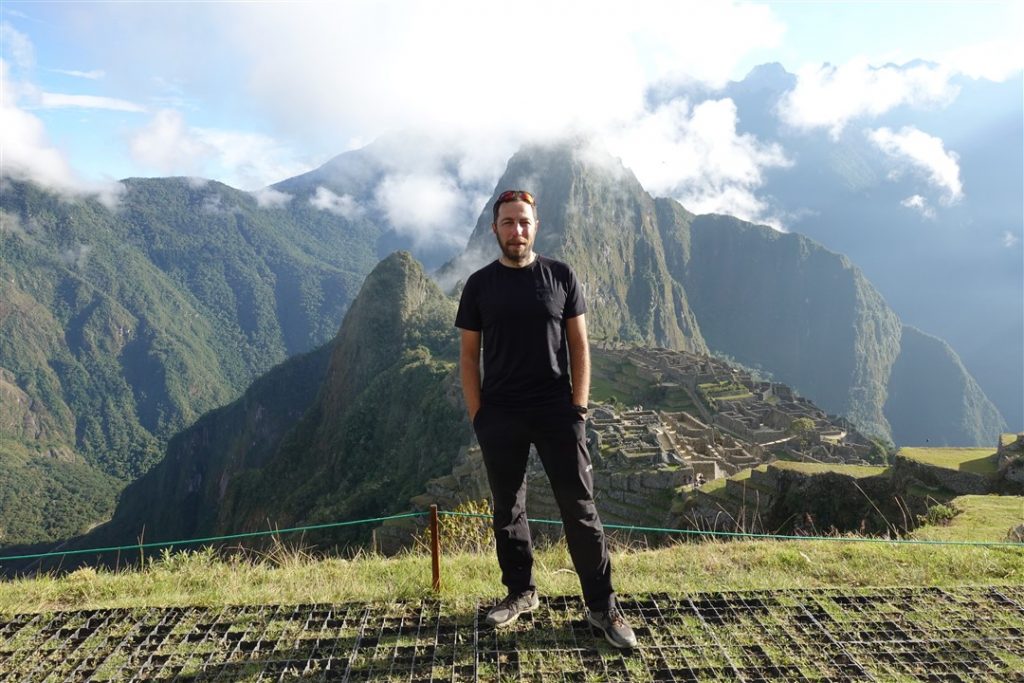
Machu Picchu is called as lost city by many people but actually it wasn’t hidden on purpose on the period it was constructed. When it was explored by the American explorer Hiram Bingham in 1911, the natives were aware of the city. They used to graze their animals there.

The iconic city Machu Picchu of Incas was unearthed after the natives showed the place to Hiram. I turned out that this ancient city was built in 1450 A.D. Since we know that the Spanish started to colonize this continent in early 1500s, it is interesting that it could only be discovered after 406 years had passed. Hiram asked to the villagers who took him to the ancient city: “Since when are you living here?”.
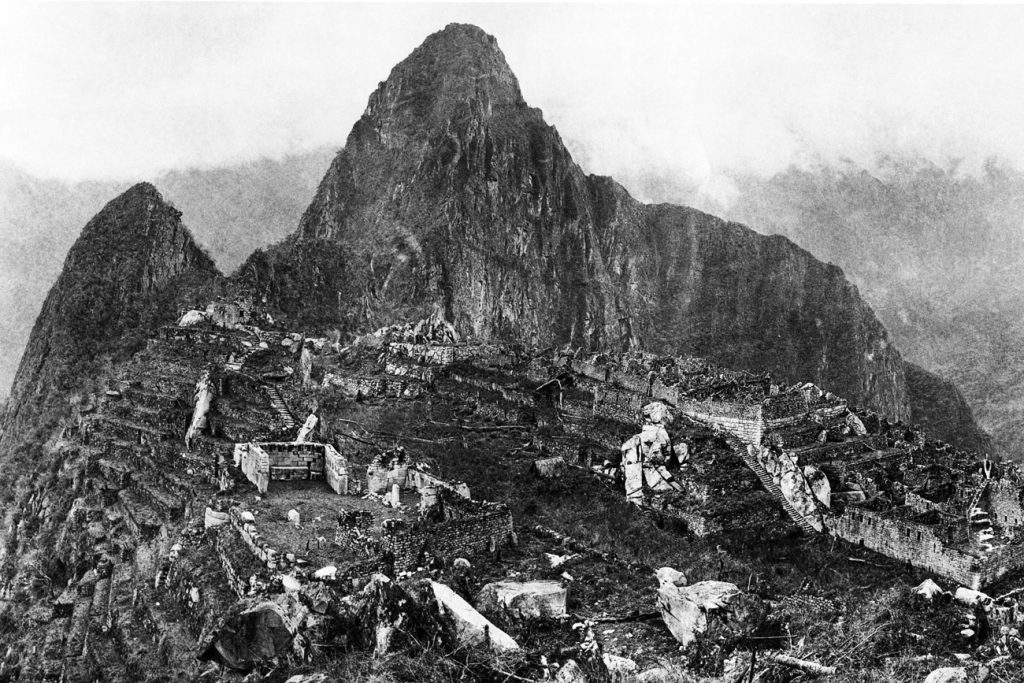
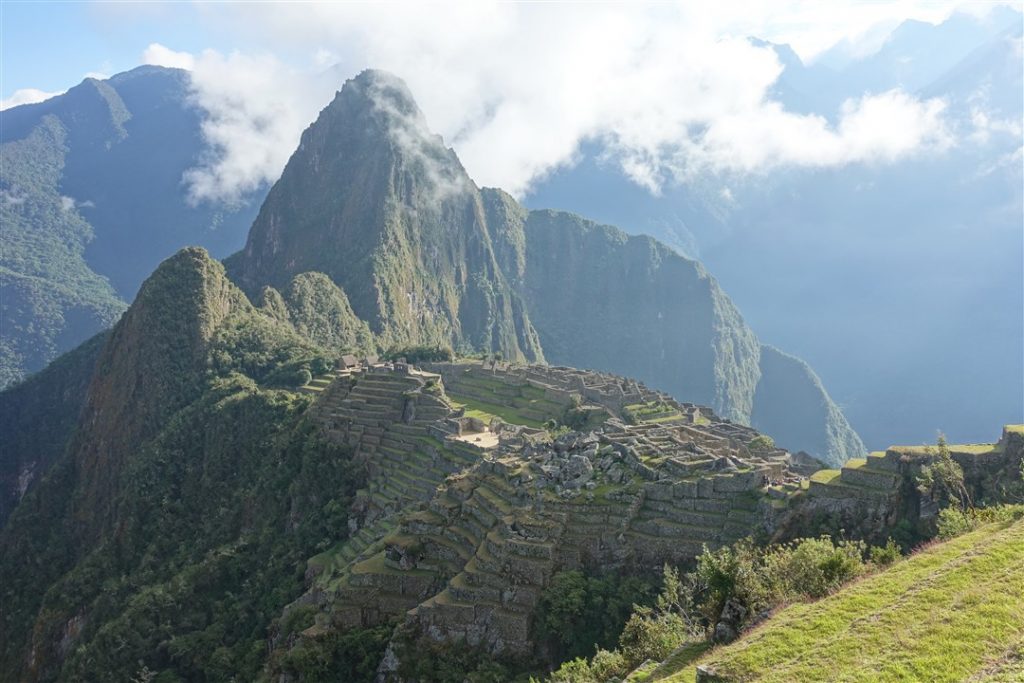
That family had settled down in 1906 in this place after the government started to construct roads. They incidentally found this ancient city while grazing their animals and looking for suitable farmland. As I mentioned above, “the naturality is destructed, where ever the road reaches” These natives had explored this place after the roads were constructed.
The name of this city which remained unknown for more than 400 years is not Machu Picchu. Nobody left any inscription with the name of the city in this area abandoned under Spanish occupation. The family who showed this place to Hiram was living there since only 6 years. There were other explorers who came to this area in 1834 and 1902 but were not able to see the ruins hidden by trees in this valley.
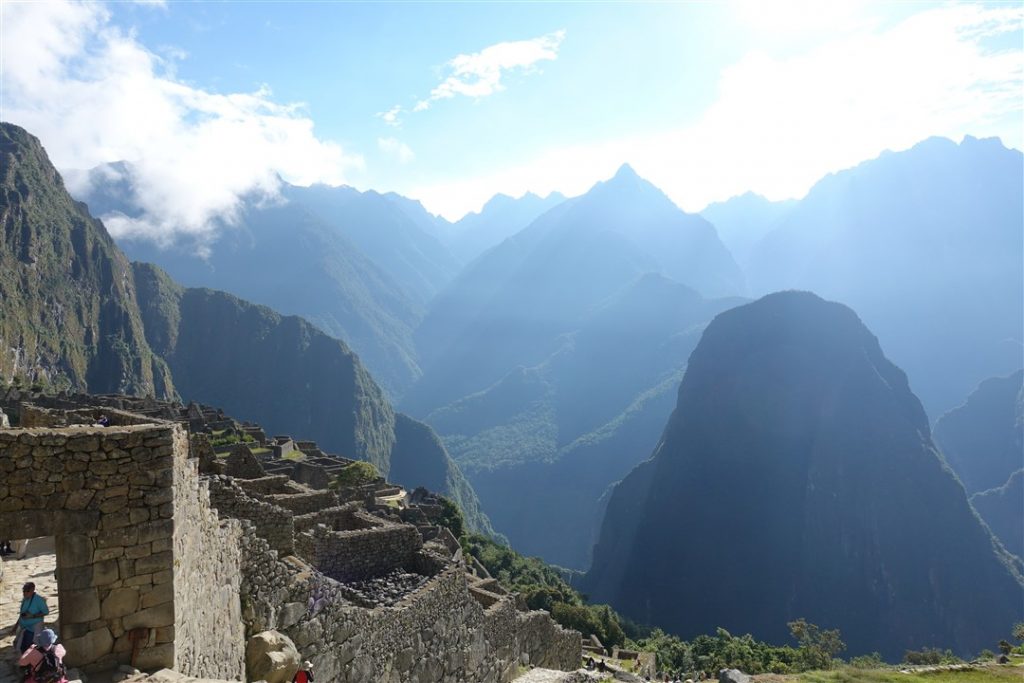
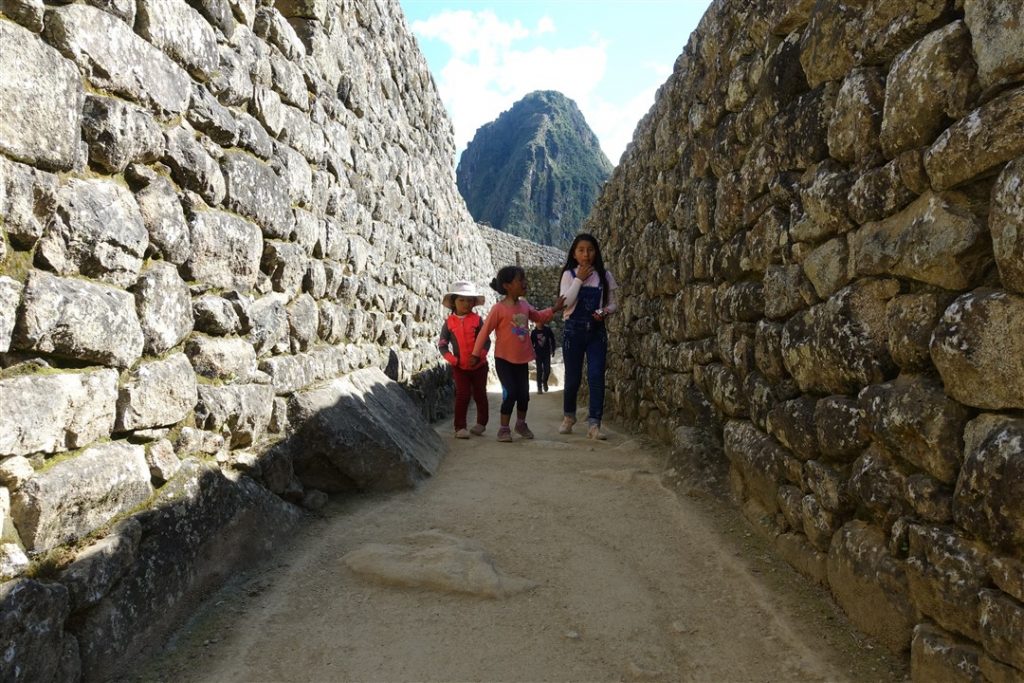

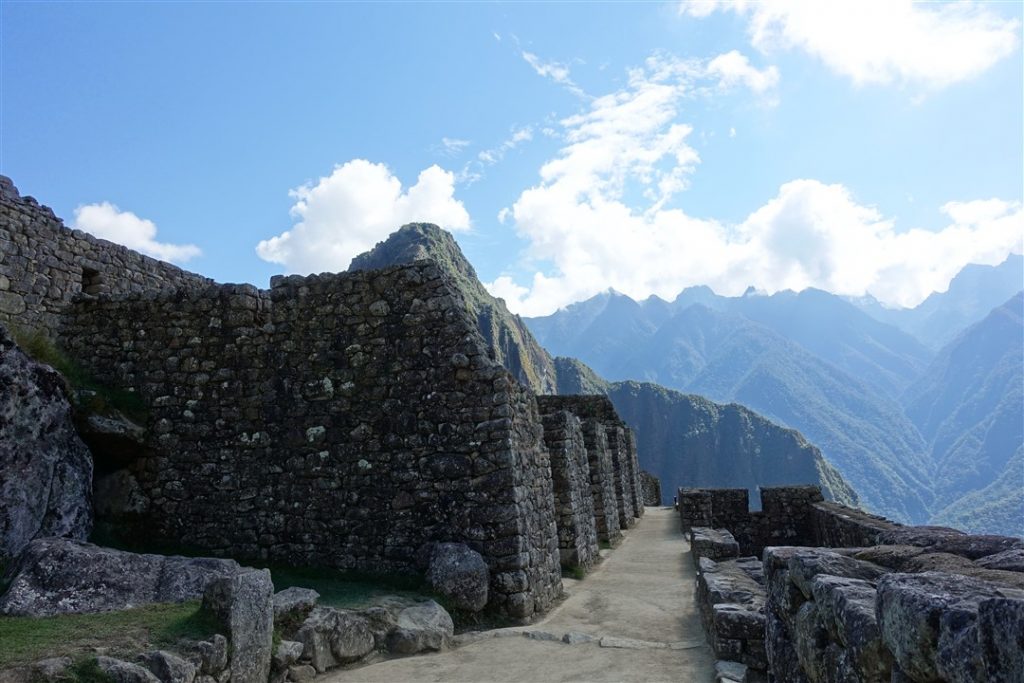
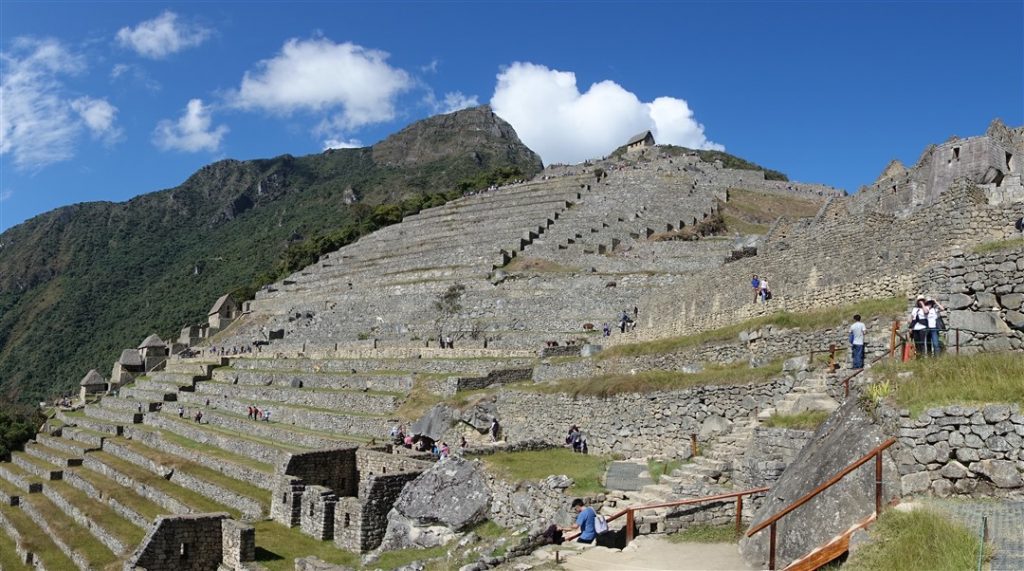
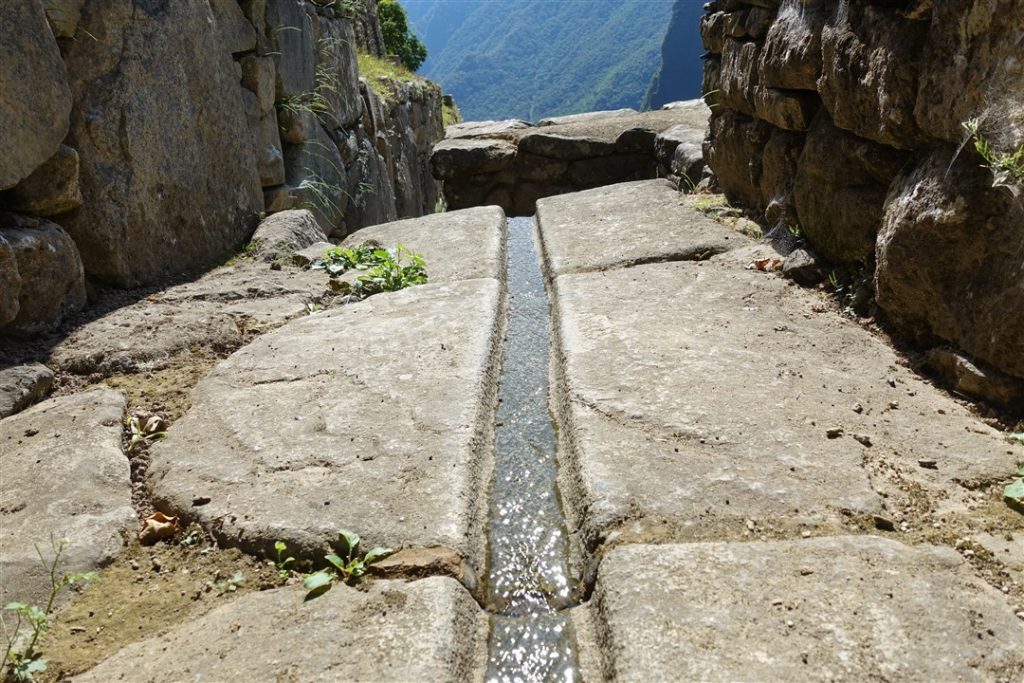
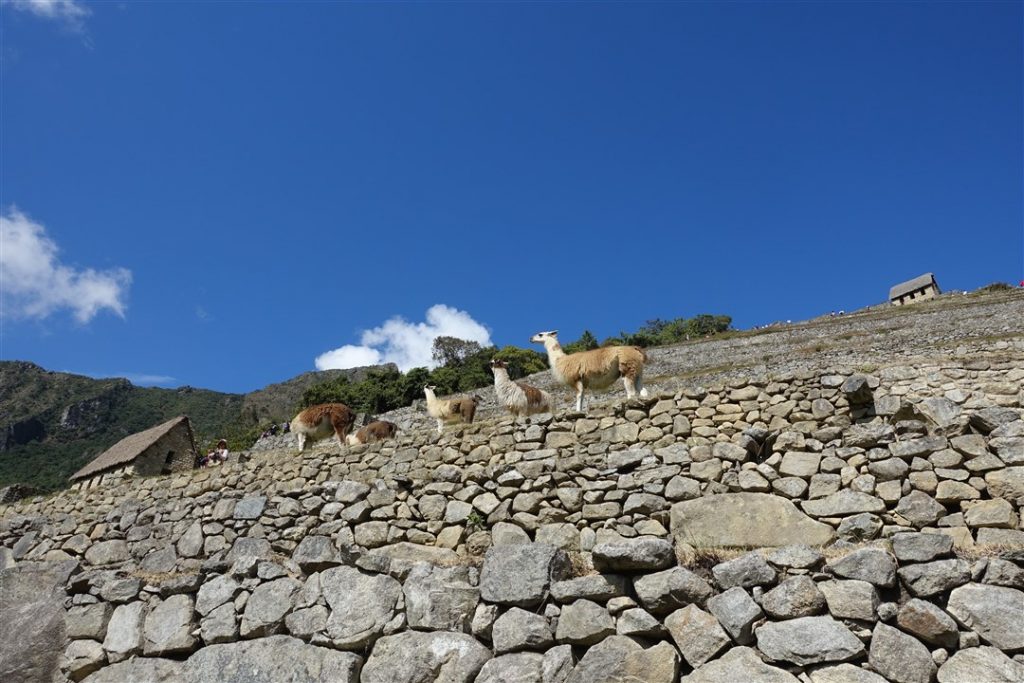
The dwellings seen on this photograph taken from above belong to the unearthed city, actually there are other dwellings and a system of terraces reaching down the valley still remaining buried under the ground and also on the other side of the valley. You can partly see them when walking down. Also, Hiram first saw this first part down in the valley and walking up to the top came upon this grandioso stone masonry.
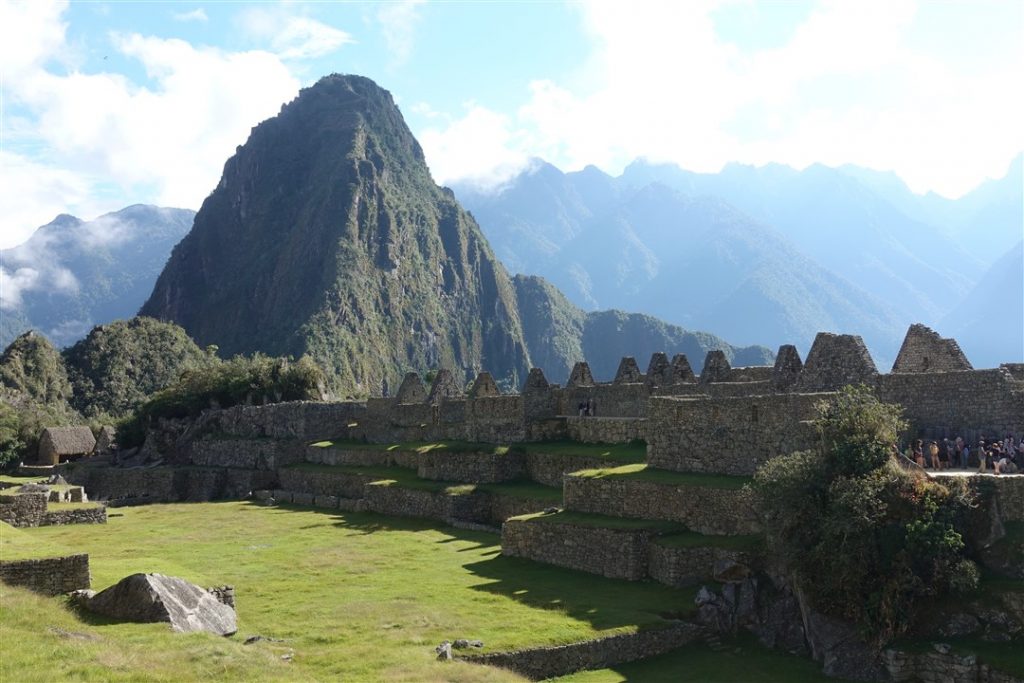

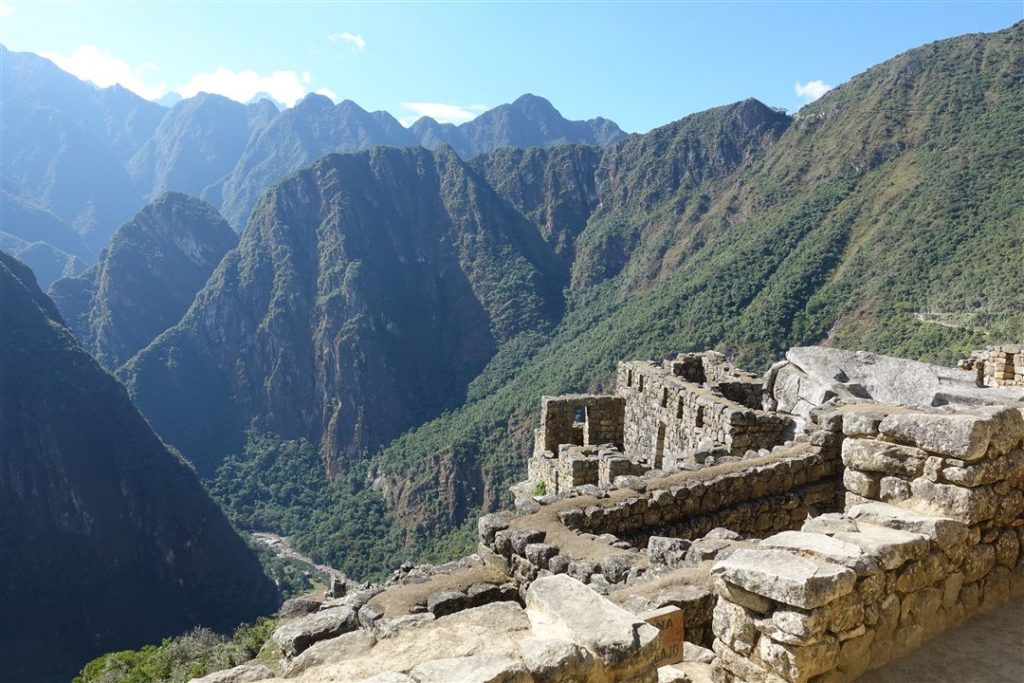
From morning till noon time, I walked around every corner in this place. I must say that this is the most magnificent ancient city in terms of its location I have visited so far. But in terms of details as the masonry remained up to now, dwelling design, etc. etc. it remains far back on the ancient cities’ list. I’m not exaggerating. There are fascinating ancient cities in Africa and Asia with beautiful masonry. I’m pointing to its location which is not open to discussion, just fascinating. Well, at this point there are many questions. The reason why Machu Picchu was constructed is still a subject of theses.

Hiram in his notes mentioned about this place as a castle which was built to escape. Castle means soldier, soldier means logistics. This area is outside the normal trade route of Incas. The mountain is surrounded by fertile agriculture land. Also, terracing was done to gain agricultural land but with low productivity. Anyway, it is not feasible to apply the system of terraces everywhere. You see nice masonry at the Temple of the Sun and the Temple of the Condor (By the way, aside these to temples all the dwellings and even the terrace walls are restored. There is a huge difference between the masonry of stones at the bottom and of the stones upper.)
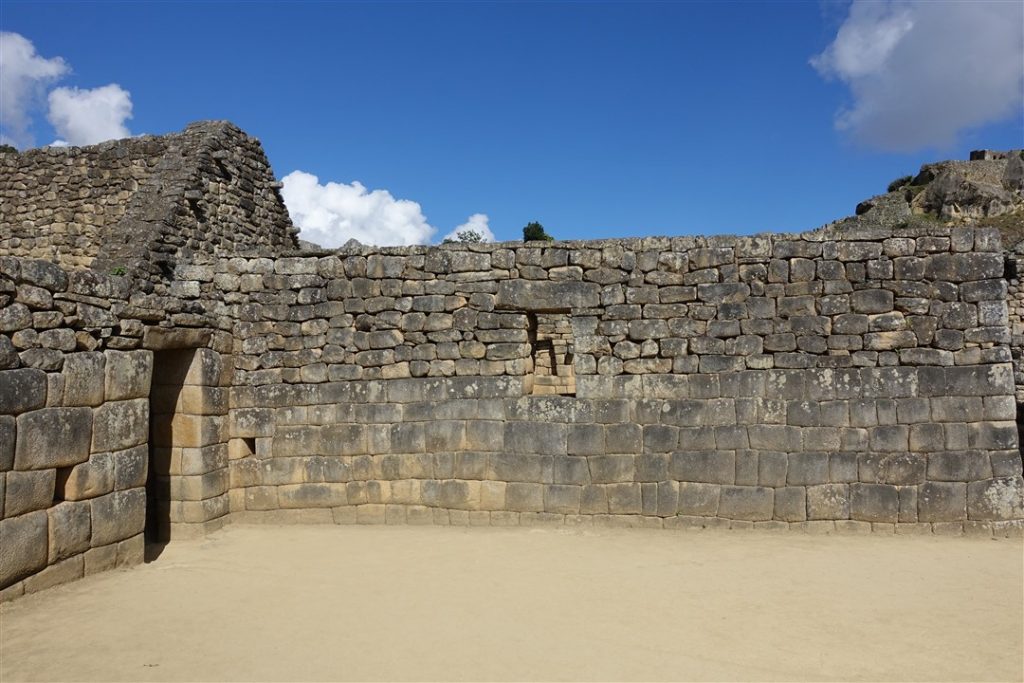
As I mentioned above, natives don’t know the stone masonry their ancestors had done. That is, Machu Picchu has not remained to the present as it was built (it has been restored for over 100 years, the information given by the archeologists to me). If this was a castle, what was it protecting? It is obvious not built to protect the agricultural fields. Some information related to the temple with window located at the upper side of the Temple of the Sun in Machu Pichu was found in Cusco and Urubamba.
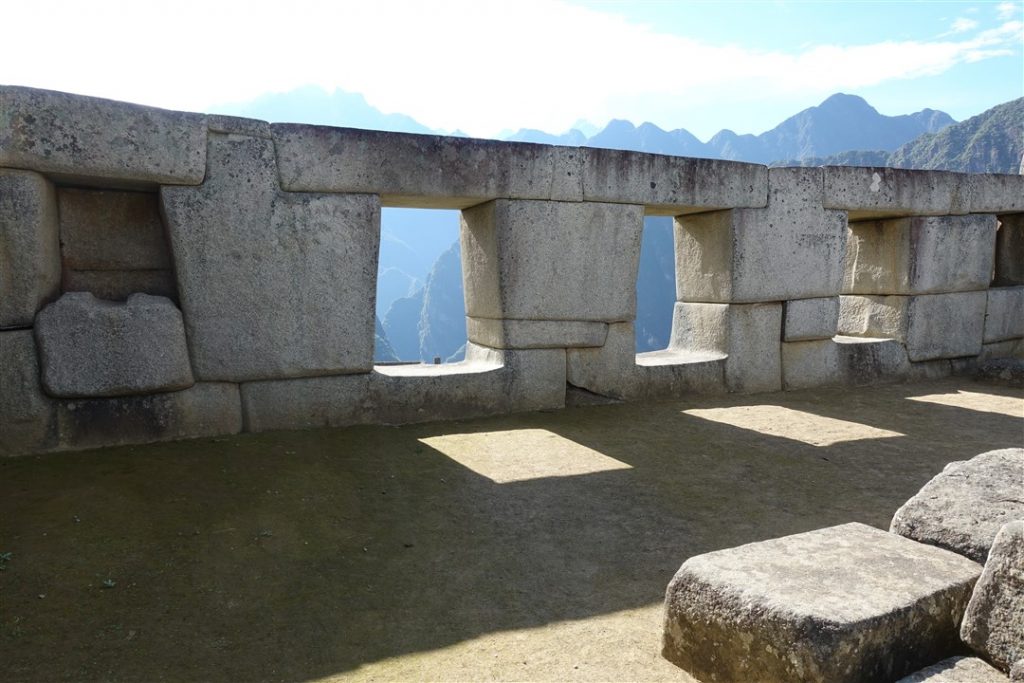
But there no other temples having windows both facing the Temple of the Sun and the mountains aside that temple in Machu Picchu, at least not recorded yet. The historian Hiram, based on this fact claimed that this probably was the place where the name Inca originated, the area where Incas initially had lived, settled down. It could be. Maybe, the family originating from this place founded the Inca Empire and returned to establish this settlement.
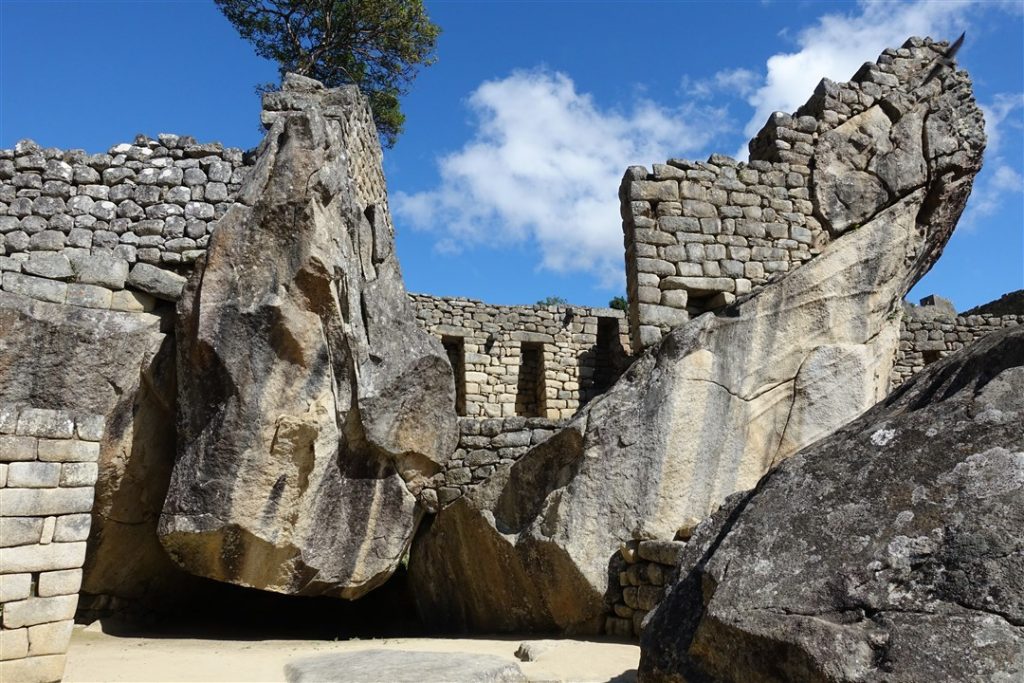
The ones shortly visiting the ancient city at 6 a.m., cannot visit the Condor Temple which opens at 10 a.m. There aren’t any signs or information boards at such a huge area not in Spanish nor in any other language. I don’t have to hire a guide at the entrance! There is a huge amount of information on the internet, hundreds of explanations, commentaries which I can read, and I did this. If Peruvian government asks 45 USD for entrance for this ancient city, then why not ask 100 USD for Ephesus Theatre, 200 USD for the palaces in Istanbul, 300 USD for Cappadocia. Another big problem is that there aren’t any restrooms inside. I didn’t go to the toilet for 8 hours. Dude, the restrooms are outside the entrance and once you exit the place, you are not allowed to reenter.
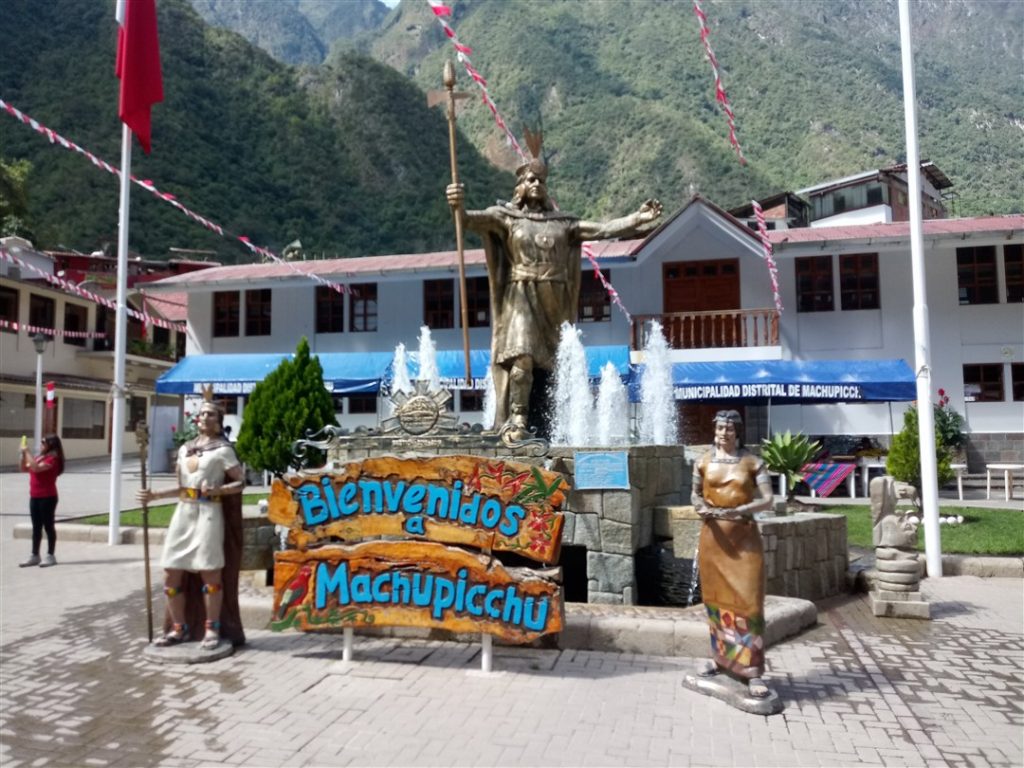
The entrance ticket, 8 times transportation vehicle and hotel accommodation for one night, the whole Machu Picchu visit 1 night, and 2 days costed only 85 USD in 2019. But if you prefer to take train for your comfort, take the bus to go to the ancient city and stay at a better hotel in the city for 2 days it will cost about 400 to 500 USD.

Exiting Machu Picchu, I started to walk along that railroad and passing the hydroelectrical plant I arrived in a small town. From there I took a minibus to Santa Maria. Well, when I come back to the main road, I’ll either go to the direction towards Calca or towards Amazonas. Dude, that was not my attention but why not take a short look at the Amazonas at the Peruvian side. So, I went to Santuario National Park which is a part of Amazonas. I also visited Quillabamba, Quellouno, Kiteni, Kimbiri, Pichari. The moisture is 300%, I’m about to pass away, it is inhuman. The roads made me to puke my guts out. I’m really pissed off. On the paved road the driver started to drift on that single lane narrow road. He is trying to make the sliding sound of the tyers at the bends, asshole. After a point, I got fed up and started to swear half in Turkish, half in Spanish and only then after he slowed down.
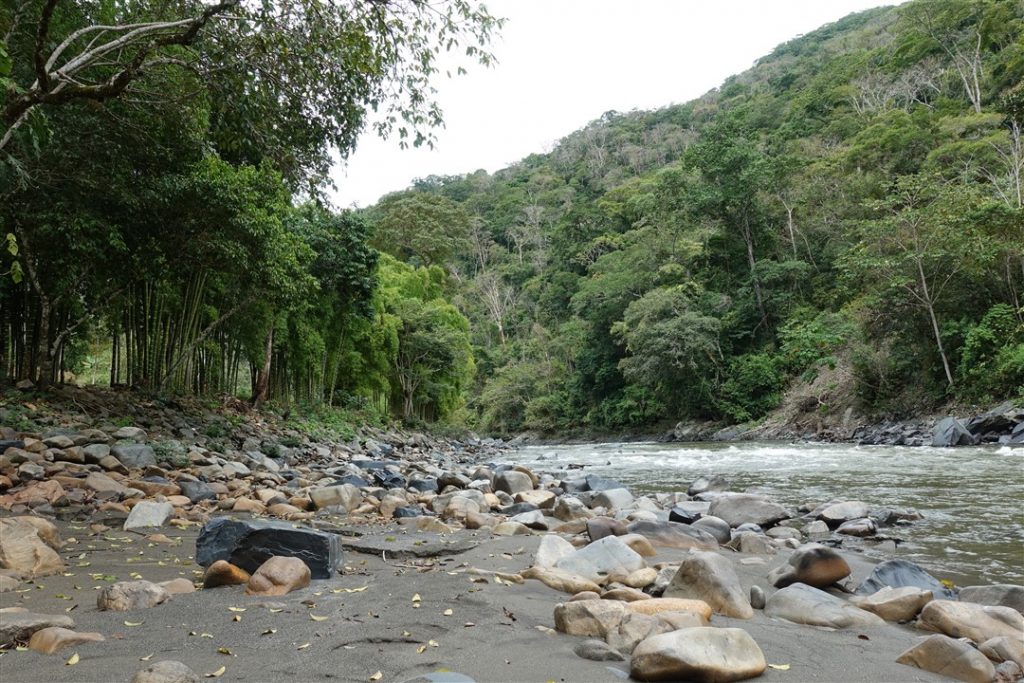


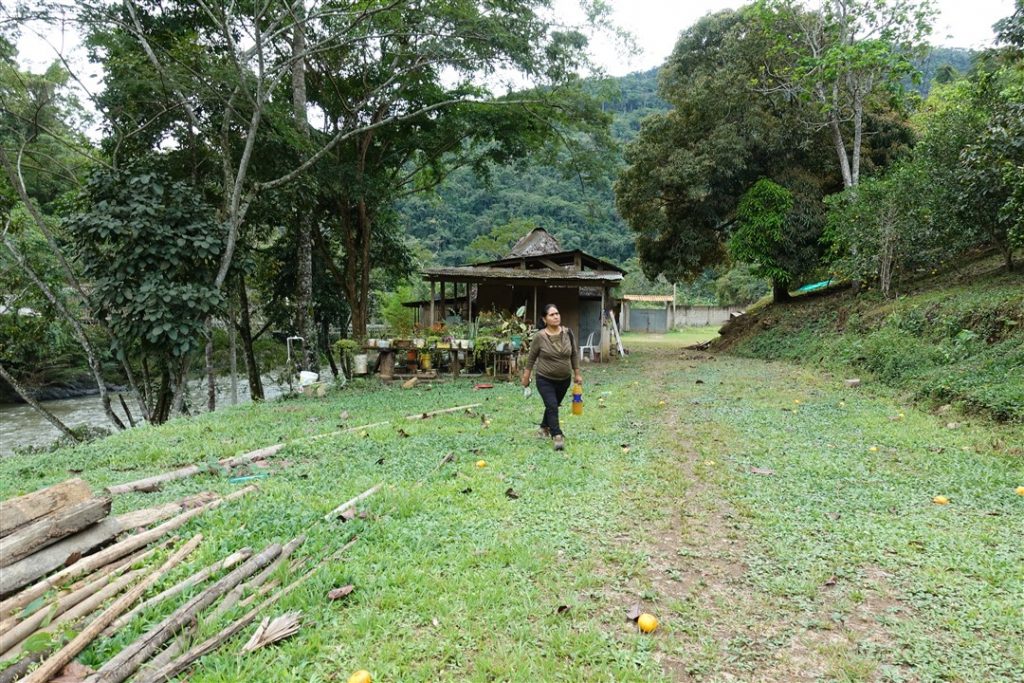
We generally hear about the environmental destruction of Amazonas in Brazil but both Peru and Colombia also have large parts of land in Amazonas region. I guess Brazil is more in sight than the other countries, therefore the issues in Peru don’t catch people’s attention. The Peruvians destroy their part of forest due to natural gas reserves. Adding the agricultural activities and the release of chemicals to the nature, make things worse. But nobody cares. The natives don’t show a fucking interest.
At the end of 5 days I returned to Calca to the hostel of Mert and Alper. I spent there a couple of days. Though it was a right place to stay and spend some time, after a good rest, the time say goodbye came.
Before setting off, I asked Alper and Mert about the mountain road I had seen before at the entrance of the town. I’m possessed by this road, I definitely want to climb this road but if it does not connect to somewhere, I don’t want to ride all the way back. Well, this road had a connection to Cusco somehow but nobody I know had gone on this road before, not Alper, nor Mert, nor my traveler friends, nor the touring cyclists I was following mentioned this road in their memories. I think, someone must have used it, but I not to my knowledge. Alper said once:
-Gurkan this road is closed to motorized vehicle transport because two minibuses have fallen down the cliff. On the top, you can see the Huchuy Qosgo (Juchuy Coscco) remnants.
-Are there ancient ruins on the top?
-Yes, but this road is already difficult to walk on, how come you will climb with your bike to the top?
-It seems that the road reaches the top
-Yes, but it is too steep.
-Well, now you said that this road connects to Cusco on the other side of the hill and that there are ancient ruins. Wow, for sure I’m going to take this road. Tomorrow I’ll set off and send you a message after I climb to the top.
-You are crazy, I don’t say anything anymore.
Before setting off, I opened the topographic map on Garmin Montana 680 GPS device at night and examined the heights. The winding road climbs up from 2923 m altitude to 3691 m within 10 km distance. There is a 76.8 m climb per km for 768 m on dirt road. I had climbed at steeper and worse places but never performed such a steep climb above 3000 m altitude. I had ridden at 4000 and 5000 m altitudes with only soft climbs. Anyway, let see what’s waiting for me.


The next day I said good-bye to everyone and set off. I didn’t start very early because I was intending to camp overnight next to the ancient ruins. I climb slowly and take it easy, watch the view while slowly approaching to the top. A spectacular view. Arriving at 3400 m altitude, I stop, sit down my legs hanging down the roadside and start to cook pasta.
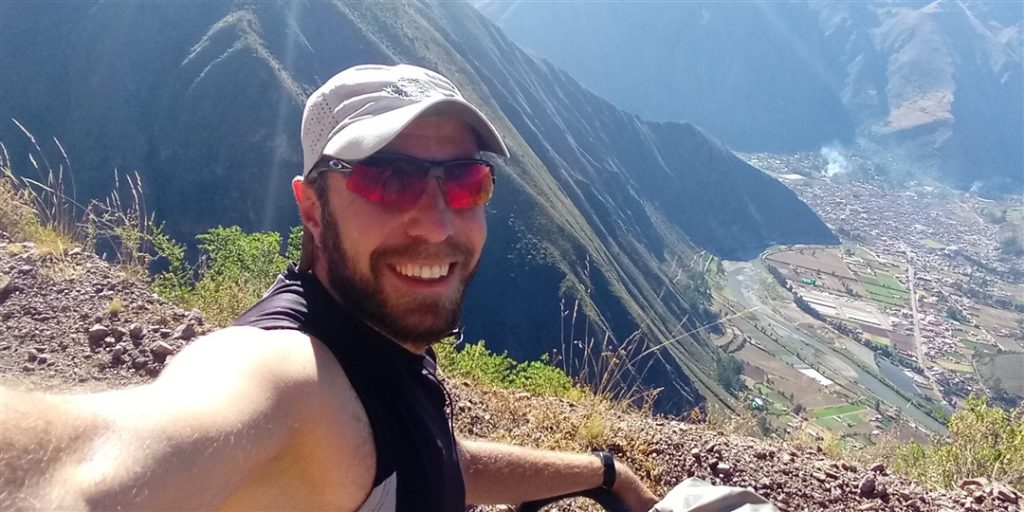
While cooking I look at the mountains ahead. Well, the surface of the mountain looks strange, this already caught my attention while riding down to the Sacred Valley. You see the endless mountains and these strange ripples on their surfaces. While eating, I think about this at the same time. There isn’t strong wind. I had seen before how wind draw nice patterns on the sand dunes in the desert. Well, are these the ancient farm terraces remained buried under the soil? How come? This is a huge area, looks endless, not all the mountains were terraced for farming, or were they? Anyway, maybe I meet someone at the top and ask about this.
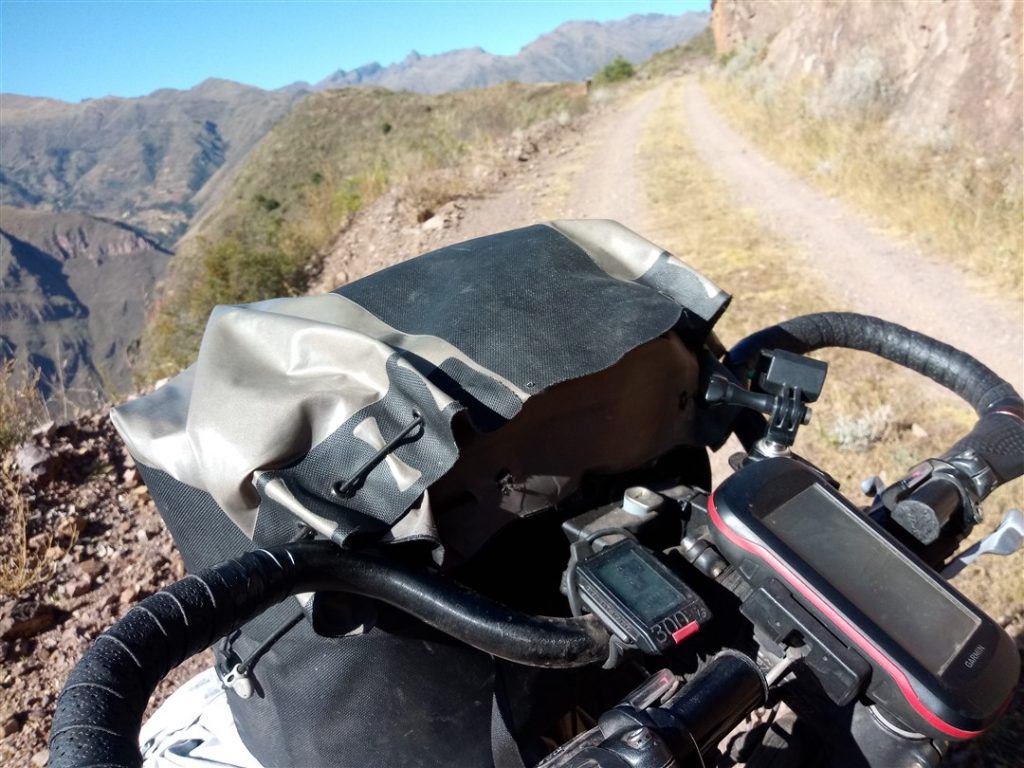

After 2 hours of climb I arrive at Huchuy Qosgo. Dude, what a place. I was not expecting to arrive at a settlement like that. Following a very narrow path I arrive at the place and the goat path ends, I have to push my bike on grass. While going up, the archeologists making restoration work look at me and talk. Wow, great! I have so many crazy questions in my mind, I came up to the right people.
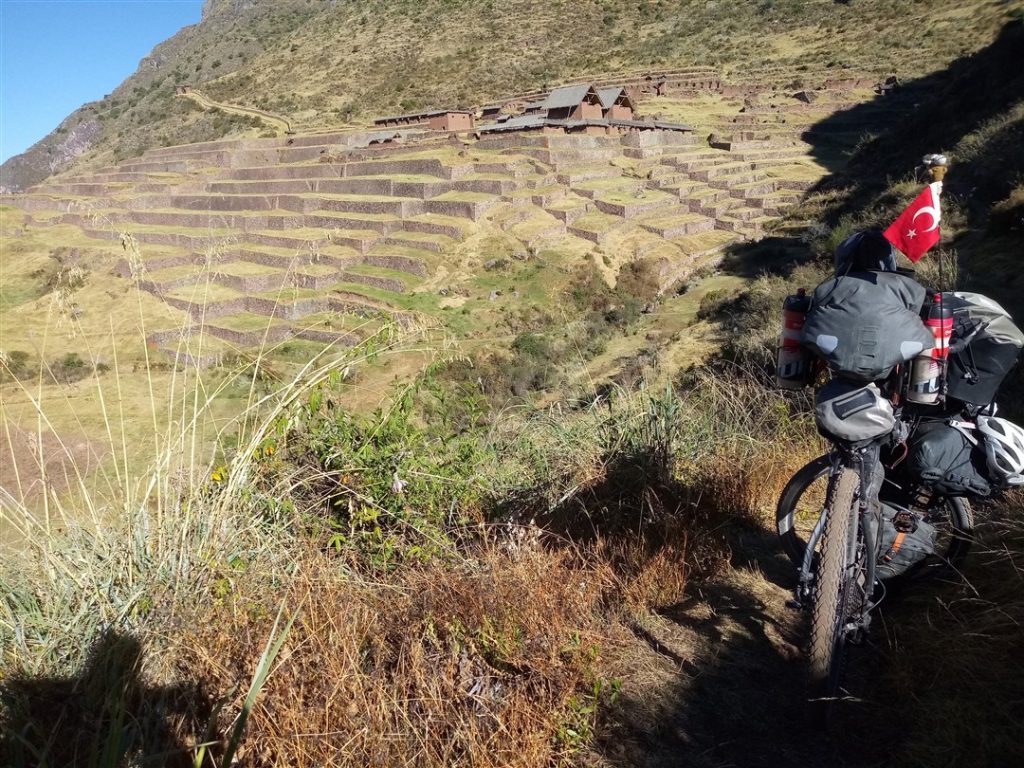
– Salam alaykum, how are you aga? (Well, of course I don’t talk like that.. Beginning with Hola, I continue with some Spanish and English)
-You are the fifth cyclist who came to this place this year, but the others didn’t have load on their bikes.
-It was a hard climb.
-If you are riding towards Cusco, I must say that your adventure hasn’t started yet.
-How come?
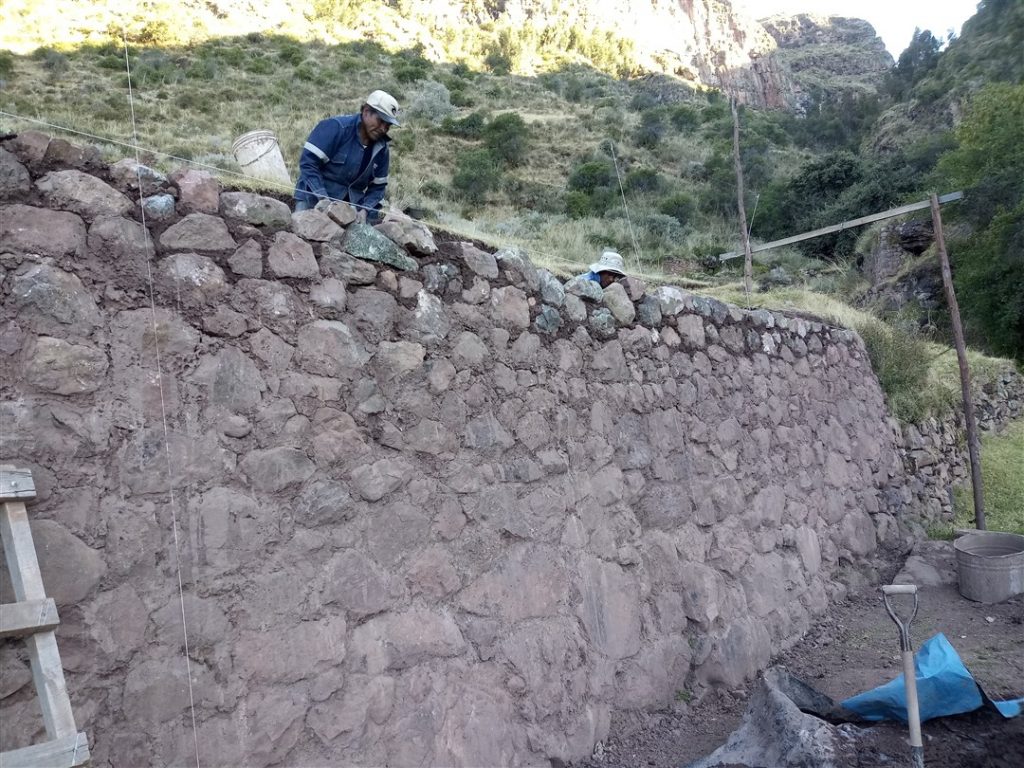
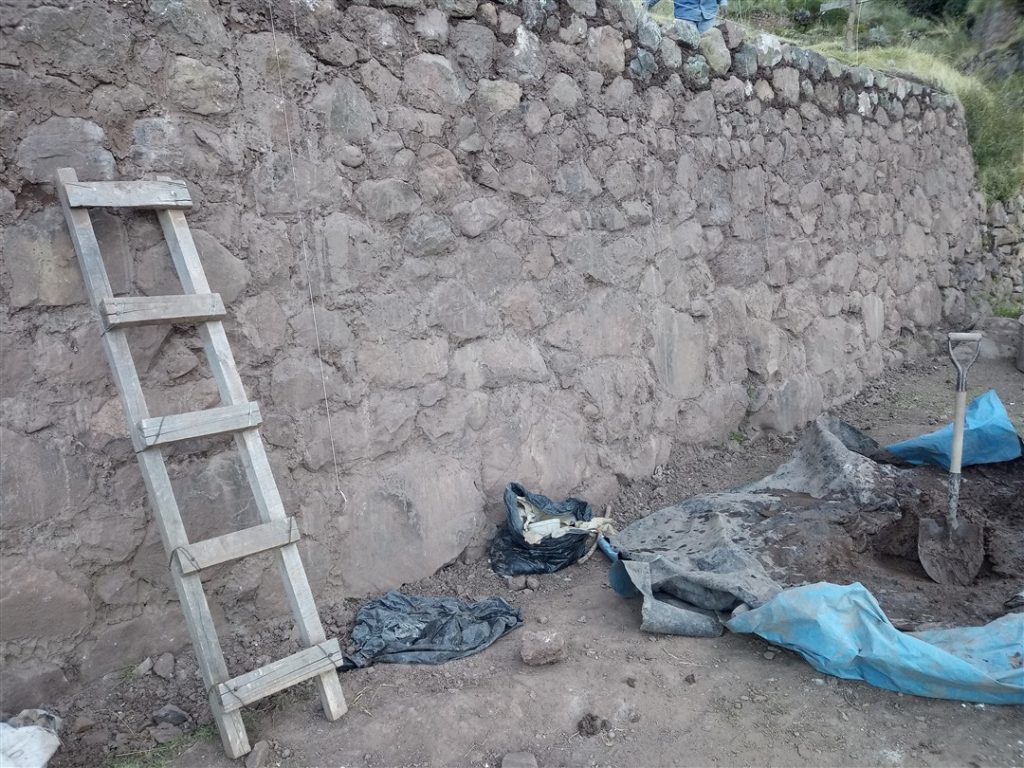
Dudeeee, the real fun is after this point. This road is not suitable for motorized vehicles, frankly also not for my bicycle. Let me explain in this way: The next day I could cover only 20 km in 10 hours. I had to carry my bicycle for 2 km, had to push for 10 km and could ride only for 8 km. My pulse rose to 190 on that day when I climbed 650 m at 4500 m altitude, my heart was about to explode. Plus, there were places for pure adrenalin. When I shared that I passed this route on social media, Nacho from 260 Litros group sent me a message:
– Gurkan, you are one of the most screwed person I have ever met in my life. We almost died from exhaustion when riding with unloaded bicycles on this route. What the hell did you do Gurkan!
-Nacho, I kicked the bucket. Dude, if I had known that you passed through this route, I would ask you and wouldn’t take it.
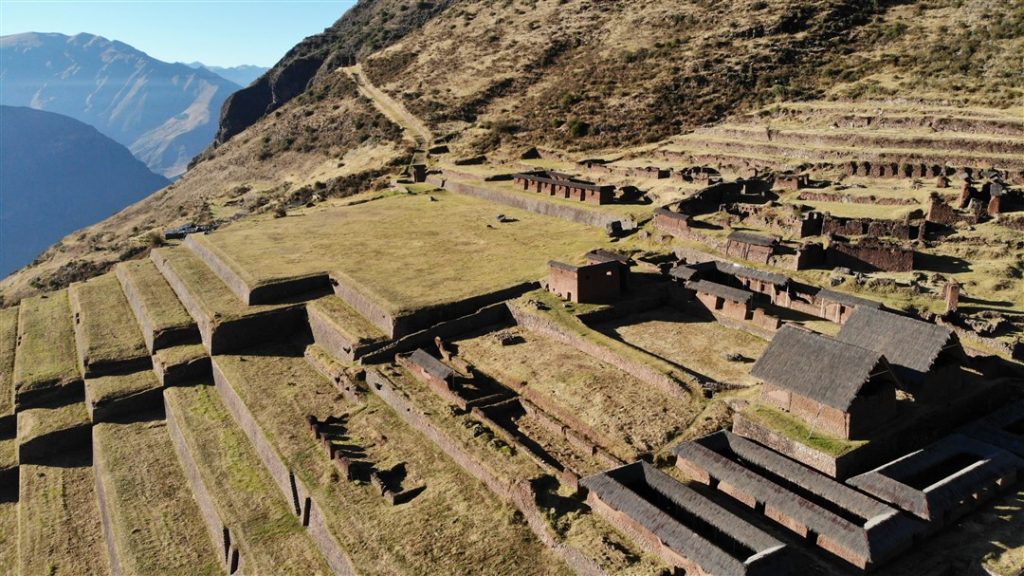
But at the end I reached at such a nice place, the view is marvelous. Did I get permission to overnight there from the archeologists? Normally, it is not allowed to camp next to the ancient cities in Peru. Did I get permission to fly a drone? Normally, this is also forbidden. But putting some sweet lines resolves everything and I got the permissions. One of the archeologists came to my tent and asked the classical questions, where I’m from, what I’m doing, etc. Javier appreciated what I was doing and invited me to his home at the other side of the mountain for the next day. It was nice to meet him. I shared my opinion about the stone masonry with him. He said: “You are right, there is no one continuing to perform this type stonework in Peru.” He showed the difference between the old stone masonry and the one they did now. He also said that I was right about my opinion about Machu Picchu.
– Javier, the surface on the mountains is somewhat different, what is the reason? The system of terraces doesn’t continue throughout the whole mountain area, does it?
– Hahaha. It does, Gurkan. Everywhere at you eye reach you can recognize the terraces.
– That is, there are a lot of agricultural fields not excavated yet.
– We don’t have the budget nor the time to excavate all. You told me that you are a writer, is this your real profession?
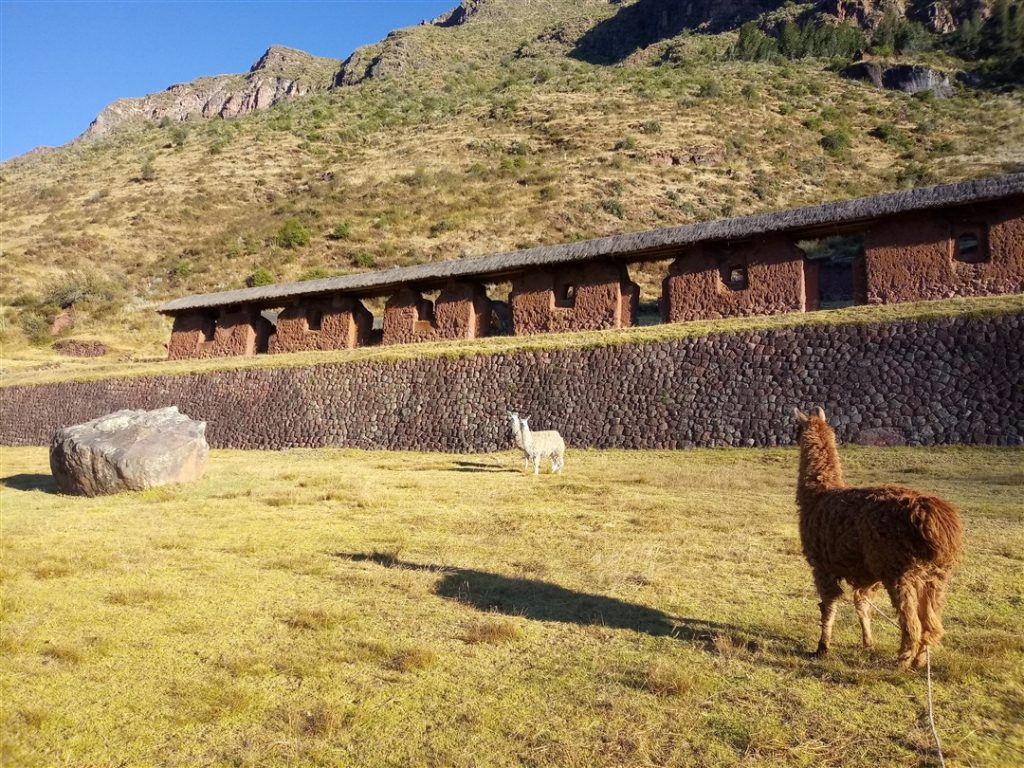
It is an area called the farm of the emperor of Inca. The Spanish after occupying Cusco continued to farm on this land. The notes dating back to colonial period mentions a special farm was established on this land by emperor for himself. The Spanish demolished the irrigation channels and many other agricultural systems after occupying this land and established their own systems.
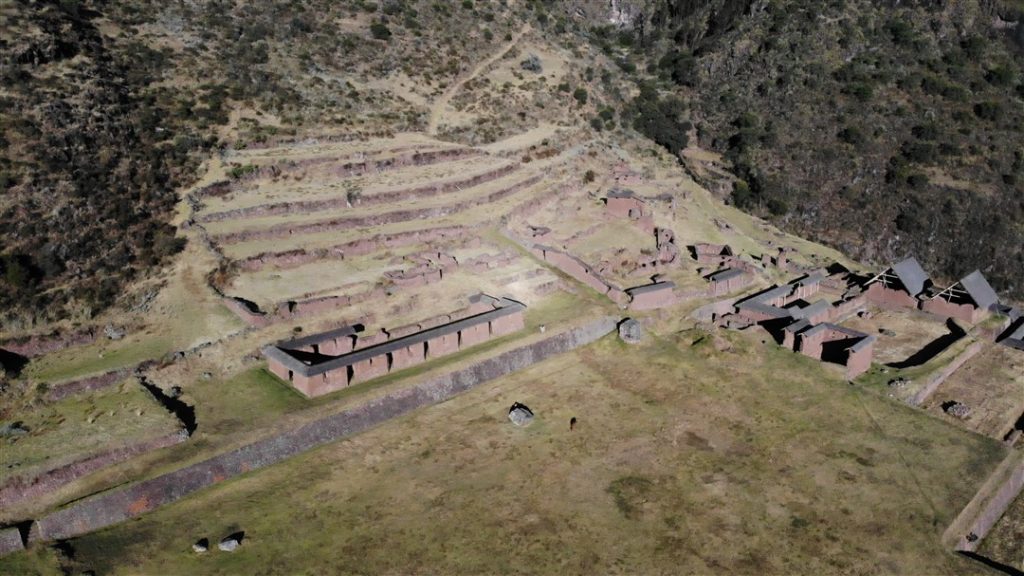
The vegetable variety is rich on this terracing system. As I have mentioned above, the altitude changes 800 m within 10 km distance. Farmers gained farming land using a system of terraces and for example are able to grow green beans on these terraces at 2000 m altitude, corns on the terraces at 2200-2400 m, quinoa at 2400-2800 m. It seems that this diverse variety is due to temperature differences at every 200 m altitude and so farmers could use the soil in the best way possible. The view over the terraces down to the valley is spectacular. It is a place to hike and to camp overnight but not to ride on bike. Furthermore, the valley on the top is also magnificent. That is, you can use this road to go to Calca from Cusco without any difficulties.
Anyway, the next adventure is the Inca trail I followed till Arequipa and the highest road pass in South America. I had mentioned that one day I’ll cross this pass back in 2011, and now let me ride towards there.